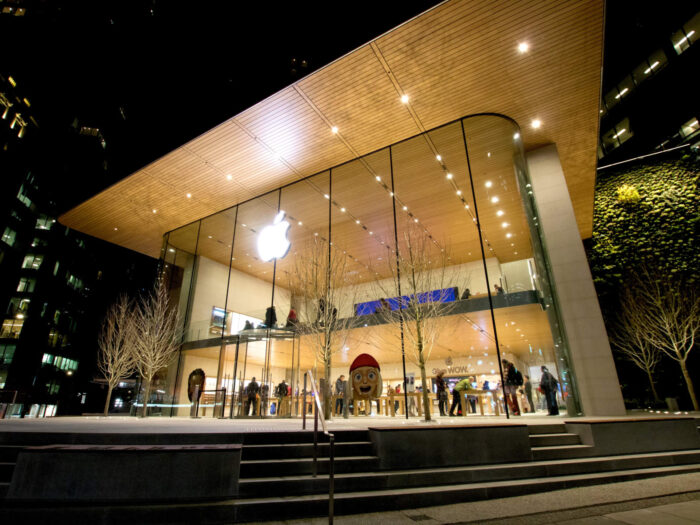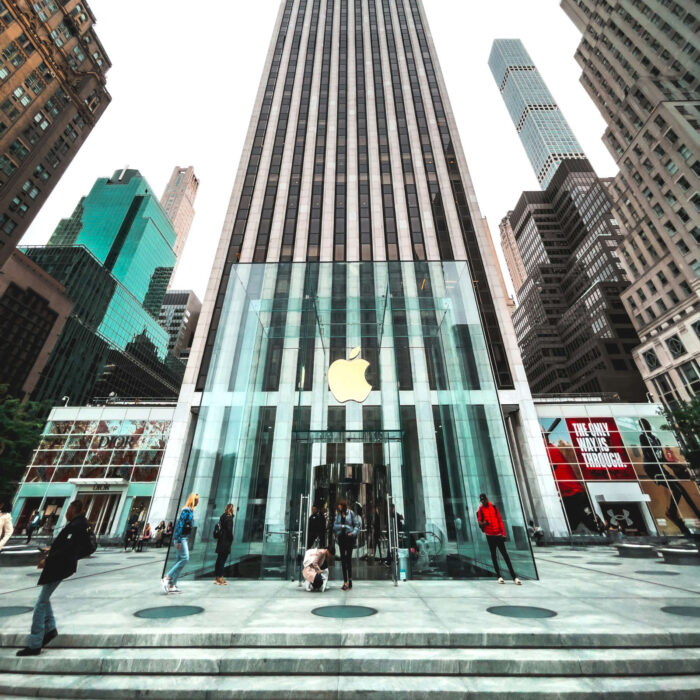
Apple’s organizational structure advances effective innovation through workforce groups, resources, and their interconnections. The company structure and organizational design enable technological innovation strategies. Apple’s vision and mission are supported through this business structure.
Apple’s organizational structure ensures industry leadership against competitors, including the information technology, consumer electronics, and online services of Google (Alphabet), Samsung, Microsoft, Amazon, and Sony, as well as Apple TV Plus streaming competitors, like Netflix, Disney, and Facebook (Meta).
The Five Forces analysis of Apple determines strong competitive forces. Apple’s company structure enables competitive advantages in the market for smartphones, tablets, laptops, desktops, and online services.
Apple’s Organizational Structure Type & Characteristics
Apple has a hierarchical organizational structure, with notable divisional characteristics and a weak functional matrix. The following are the main characteristics of Apple’s structure:
- Spoke-and-wheel hierarchy
- Product-based divisions
- Weak functional matrix
Apple’s hierarchy is a traditional structural feature in business organizations. The divisional characteristics involve product-based grouping within Apple, such as for iOS and macOS. The weak functional matrix promotes inter-divisional collaboration, while the company’s hierarchy is preserved.
Spoke-and-Wheel Hierarchy. A bird’s-eye view of Apple’s organizational structure shows a considerable hierarchy that revolves around the company’s headquarters. This structural hierarchy indicates the concentration of decision-making power at the central headquarters.
In the past, everything went through the office of Steve Jobs, who made all the major strategic management decisions. Today, under Tim Cook’s leadership, this hierarchy in Apple’s company structure has slightly changed.
The company now has more collaboration among various offices, departments, and teams in the organization, such as software teams and hardware teams. Apple’s vice presidents have more autonomy, which was limited and minimal under Jobs.
Thus, the company’s organizational structure is now less rigid, but still has a spoke-and-wheel hierarchy where Tim Cook is at the center. The CEO and senior executive team determine Apple’s organizational structure and business development.
The upper tier (innermost tier in the spoke-and-wheel circle) of Apple’s business structure has function-based grouping, which is an element derived from the functional type of organizational structure.
Senior vice presidents who report to Tim Cook handle departments based on business functions. For example, Apple has a senior vice president for retail, and a senior vice president for worldwide marketing.
In this structural feature, the company’s top leaders address business needs in terms of business function areas. This spoke-and-wheel hierarchy ensures that Apple’s top-level goals in all business areas are addressed.

Product-based Divisions. The upper and lower tiers of Apple’s business structure have product-based divisions, which is an element derived from the divisional type of organizational structure. There are senior vice presidents and vice presidents for different outputs or products.
For example, Apple has a Senior Vice President for Software Engineering (iOS and macOS), a Senior Vice President for Hardware Engineering (Mac, iPhone, and iPad), and a Senior Vice President for Hardware Technologies (hardware components).
The distribution channels in Apple’s marketing mix (4P) are linked to this structural characteristic. For example, the product-based divisions of this company structure are used in managing products or product components that the business organization delivers to its target customers in markets for computer technology, consumer electronics, digital content distribution, and other online services.
Weak Functional Matrix. Apple’s weak functional matrix refers to the collaborative interactions among various components of the business. In a weak functional matrix, top management determines project direction, while project heads have limited authority and control. For example, Apple’s business structure allows hardware teams to collaborate with software teams.
Apple’s weak functional matrix facilitates information dissemination necessary for innovation processes. This structural feature contributes to effective and rapid innovation, which is a major business strength shown in the SWOT analysis of Apple Inc.
Through this characteristic of the organizational structure, the company maintains strong innovation processes that support brand development and premium-pricing strategies. Information dissemination in Apple’s matrix encourages knowledge-sharing and organizational learning needed for innovation.
Apple’s Structure: Advantages & Disadvantages
Strong Corporate Control. The hierarchy in Apple’s organizational structure supports strong management control. Theoretically, hierarchy empowers top leaders, like Tim Cook, to control everything in the organization.
Through this corporate hierarchy, Apple’s business functions and product-based divisions are effectively guided, influenced, and supported by the decisions of the CEO and other top executives.
This advantage of Apple’s corporate structure facilitates rapid and effective organization-wide strategic management implementation and helps in establishing coherence throughout the entire company.
Limited Organizational Flexibility. Apple’s company structure has the downside of low or limited flexibility. Hierarchy typically prevents lower levels of the structure to flexibly respond to current business needs and market demands.
For example, Apple’s product-based divisions must wait for directives from the CEO or other top executives to proceed in implementing changes that address trends in the market for consumer electronics.
However, Tim Cook has already made improvements by increasing collaboration among various parts of the firm. Such collaboration improves organizational flexibility and enhances knowledge-sharing and organizational learning.
Still, Apple’s organizational structure remains considerably hierarchical. This hierarchy imparts some rigidity that limits rapid changes in business processes because everything must go through Tim Cook and the top management team.
References
- Apple Inc. Form 10-K.
- Apple Inc. Leadership.
- Chen, Z. (2024, September). Business Strategy Analysis: Evidence on Apple Inc. In Proceedings of the 2024 4th International Conference on Enterprise Management and Economic Development (ICEMED 2024) (p. 104). Springer Nature.
- Niveditha, M., & Padhy, P. C. (2024). Impact of organizational structure and commitment on organizational citizenship behavior: Insights from the IT sector. Multidisciplinary Reviews, 7(9), 2024203-2024203.
- Tsai-Lin, T. F., Chen, M. H., Chi, H. R., & Chiang, P. S. (2025). The impact of R&D organizational structure on developing technological capabilities and the moderation of R&D slack. Journal of Organizational Change Management, 38(1), 158-181.